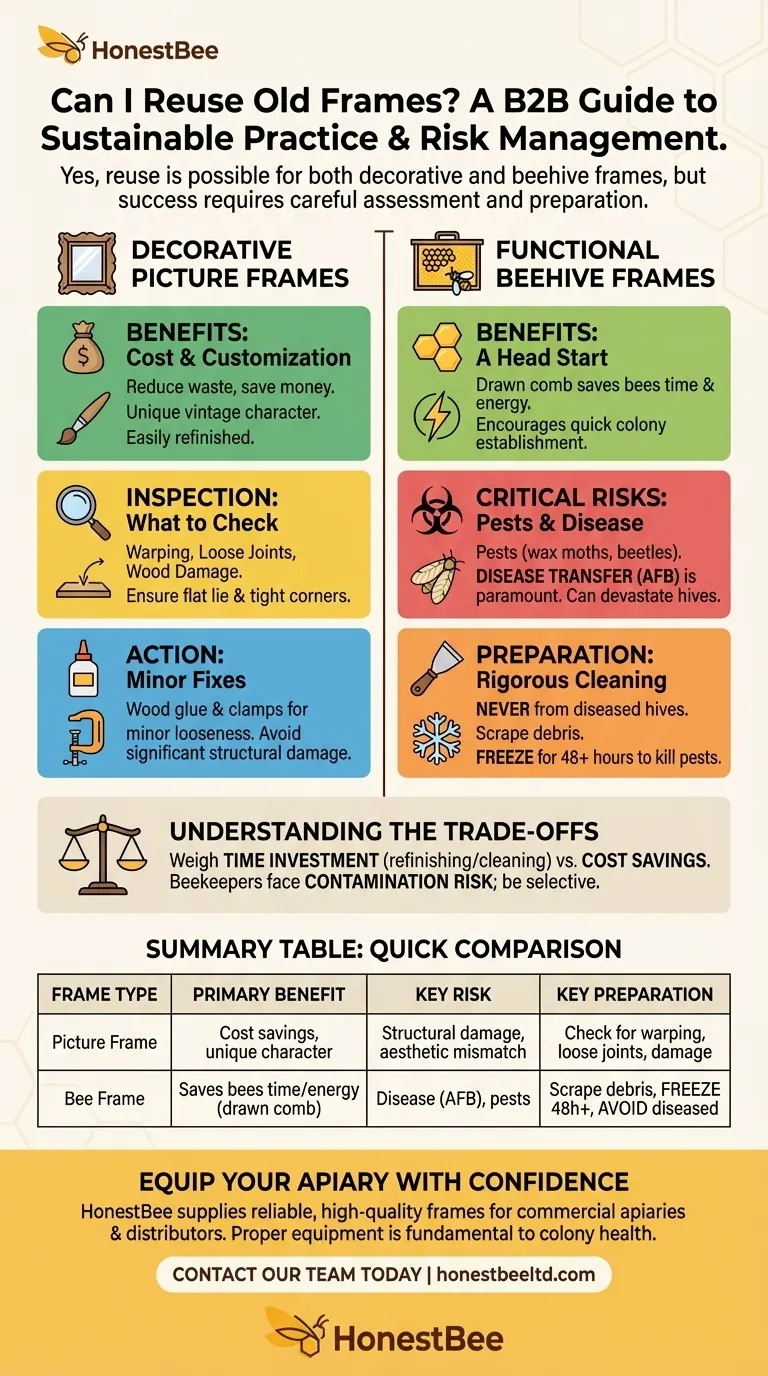Yes, you can absolutely reuse old frames. Whether you are considering a decorative picture frame or a functional beehive frame, reuse is not only possible but often a practical and sustainable choice. The key, however, lies in understanding the specific risks and preparation required for each type.
Reusing frames is an excellent practice for saving money and resources. Your success depends entirely on a careful assessment of the frame's condition and a clear understanding of its intended new purpose, as the risks associated with a picture frame are vastly different from those of a bee frame.

Reusing Decorative Picture Frames
For picture frames, the primary considerations are structural integrity and aesthetics. The risks are low, and the potential for creative renewal is high.
The Benefits: Cost and Customization
Reusing an old picture frame is an effective way to reduce waste and save money.
Beyond cost, an old frame provides a unique foundation. A vintage or worn frame has character that is difficult to replicate with new materials, and it can be easily painted or refinished to match a new style.
What to Inspect Before You Start
Before investing time in a project, check the frame's physical condition. Look for signs of warping, loose joints, or wood damage.
Ensure the corners are still tight and the frame lies flat against a surface. Minor looseness can often be fixed with wood glue and clamps, but significant structural damage may not be worth the effort.
The Critical Considerations for Bee Frames
Reusing frames in beekeeping is a common practice, but it carries biological risks that must be managed carefully. The health of your colony is the top priority.
The Primary Benefit: A Head Start
Drawn comb on an old frame is a valuable resource that saves bees significant time and energy. It can encourage a new colony to establish itself quickly or be used to bait swarm traps.
The Hidden Risk: Pests and Disease
Old frames can harbor pests like wax moth larvae or hive beetles. If left in storage, they can also be damaged by mice.
More critically, frames can carry microscopic disease spores, such as American Foulbrood (AFB), which can devastate a healthy hive. This risk of disease transfer is the single most important factor to consider.
Proper Cleaning and Preparation
Never reuse a frame from a hive that died from disease or an unknown cause. For frames from a healthy hive, proper cleaning is essential.
This typically involves scraping off old propolis and debris. Freezing the frames for at least 48 hours is also a common method to kill any potential wax moth eggs or other pests.
Understanding the Trade-offs
While reuse is beneficial, it's important to be objective about the potential downsides.
Time Investment vs. Cost Savings
Refinishing a detailed picture frame or meticulously cleaning and sterilizing dozens of bee frames requires a significant time commitment. You must weigh the value of your time against the cost of new frames.
Contamination Risk in Beekeeping
For beekeepers, the biggest trade-off is risk. Even with careful cleaning, there is always a small chance of introducing pests or disease into a thriving colony. For this reason, many experienced beekeepers are extremely selective about which frames they reuse.
Structural and Aesthetic Limits
An old picture frame may have damage that is difficult to hide, or its style might be so distinct that it cannot be easily adapted. Acknowledging these limitations upfront can save you from a frustrating project.
How to Apply This to Your Goal
Your approach to reusing a frame should be guided entirely by its purpose.
- If your primary focus is reusing picture frames: Prioritize assessing the frame's structural health before investing time in aesthetic updates like painting or refinishing.
- If your primary focus is reusing bee frames: Your first and only priority is disease and pest prevention to protect the health of your colony.
Ultimately, reusing old frames wisely is a rewarding practice that champions both sustainability and thoughtful craftsmanship.
Summary Table:
| Frame Type | Primary Benefit | Key Risk | Key Preparation |
|---|---|---|---|
| Picture Frame | Cost savings, unique character | Structural damage, aesthetic mismatch | Check for warping, loose joints, wood damage |
| Bee Frame | Saves bees time/energy with drawn comb | Disease transfer (AFB), pests (wax moths) | Scrape debris, freeze for 48+ hours, avoid diseased hives |
Ready to properly equip your apiary with reliable, high-quality frames?
At HONESTBEE, we supply commercial apiaries and beekeeping equipment distributors with durable, well-designed frames and beekeeping supplies through our wholesale-focused operations. Proper equipment is fundamental to colony health and productivity.
Contact our team today to discuss your specific needs and discover how our wholesale solutions can support your beekeeping success.
Visual Guide

Related Products
- HONESTBEE Wired and Assembled Wooden Bee Frames Foundation for a Thriving Hive
- Assembled Wooden Bee Frames with Plastic Foundation for Durability and Convenience by HONESTBEE
- Assembled Wooden Bee Frames with Beeswax Foundation Ready to Use by HONESTBEE
- Heavy-Duty Stainless Steel Clip-On Frame Perch
- Professional Wooden Requeening Frame for Beekeeping
People Also Ask
- How do wooden frames perform during honey extraction? Superior Rigidity for a Smoother Harvest
- When should I throw away my bee frame? A Guide to Hive Health & Frame Rotation
- Can old bee frames be reused? Weighing the Risks vs. Rewards for Your Hive
- What should I look for in a bee frame? A Beekeeper's Guide to Hive Health Assessment
- How should you dry bee frames after cleaning? Prevent Warping and Ensure Hive Health



















